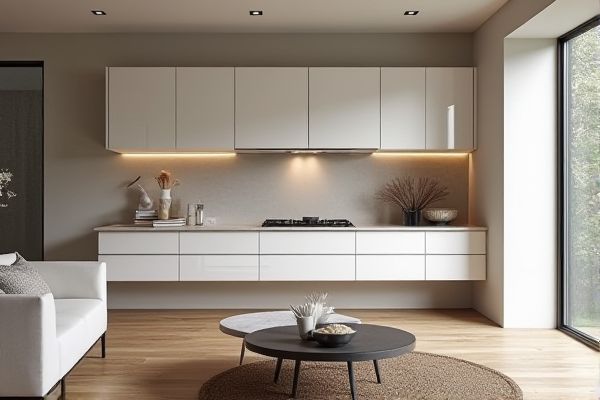
Attached cabinets offer sturdy storage by being securely fixed to walls or floors, creating a traditional and reliable kitchen layout, while floating cabinets provide a modern, minimalist aesthetic by appearing to hover above the floor and enhancing the sense of space. Explore the full article to discover which cabinet style best suits your kitchen design and functional needs.
Table of Comparison
| Feature | Attached Cabinets | Floating Cabinets |
|---|---|---|
| Installation | Fixed directly to walls or floor for maximum stability | Mounted on walls, no floor contact, creating a floating effect |
| Space Perception | Can make rooms appear smaller and more crowded | Creates an open, airy look, enhancing room size perception |
| Cleaning | Harder to clean around base and under cabinets | Easy to clean underneath due to elevated design |
| Storage Capacity | Typically offers more storage due to floor-to-ceiling reach | Limited storage capacity; prioritizes design over volume |
| Durability | Highly durable, supports heavy loads better | Durability depends on wall strength and mounting hardware |
| Aesthetic Appeal | Classic, traditional look | Modern, minimalist style |
| Installation Cost | Generally lower cost due to straightforward installation | Higher cost due to specialized mounting requirements |
Introduction to Attached and Floating Cabinets
Attached cabinets are securely fixed to walls or built-in structures, providing enhanced stability and maximizing storage space in kitchens, bathrooms, and offices. Floating cabinets, mounted without visible brackets or supports, create a modern, minimalist aesthetic while allowing for easier floor cleaning and flexible room layouts. Both options vary in installation complexity, weight capacity, and design adaptability, catering to diverse interior design preferences and functional requirements.
Key Differences Between Attached and Floating Cabinets
Attached cabinets are securely fixed to the wall or floor, providing enhanced stability and significant storage capacity ideal for heavy items, whereas floating cabinets are mounted directly onto the wall without support from the floor, creating a modern, minimalist aesthetic and allowing for easy floor cleaning. Floating cabinets offer a sense of spaciousness and are often used in contemporary kitchens and bathrooms, while attached cabinets deliver greater durability and support for larger or more frequent storage needs. Choosing between attached and floating cabinets depends on your design preferences, load requirements, and maintenance considerations.
Pros and Cons of Attached Cabinets
Attached cabinets offer superior stability and increased storage capacity by being securely fixed to walls, making them ideal for heavy items and maximizing kitchen space. However, installation can be more complex and permanent, limiting flexibility in kitchen redesigns and potential damage to walls during removal. They generally provide a traditional aesthetic but may restrict airflow and cleaning access compared to floating cabinets.
Pros and Cons of Floating Cabinets
Floating cabinets offer a sleek, modern aesthetic by being mounted directly on the wall, creating a spacious feel and making floor cleaning easier. They can be more challenging to install and may require reinforced wall support to handle heavy loads, limiting storage capacity compared to attached cabinets. While attached cabinets provide more robust stability and potentially greater storage, floating cabinets enhance contemporary design and accessibility, particularly in smaller or minimalist spaces.
Space-Saving Benefits: Attached vs Floating Cabinets
Attached cabinets offer significant space-saving benefits by utilizing wall space efficiently and providing ample storage without occupying floor area, making them ideal for smaller rooms. Floating cabinets enhance space perception by keeping floor areas clear, facilitating easier cleaning and creating a visually open environment that maximizes the usable room footprint. Choosing between attached and floating cabinets depends on the balance between maximizing storage capacity and maintaining an airy, uncluttered aesthetic in confined living spaces.
Aesthetic Appeal and Design Versatility
Attached cabinets provide a traditional, solid look that seamlessly integrates with existing walls, offering a timeless aesthetic appeal suited for classic interiors. Floating cabinets enhance design versatility by creating an illusion of space and modernity, making your room appear larger and more open with their sleek, elevated placement. Your choice between attached and floating cabinets will impact the overall ambiance, allowing you to tailor the visual flow and style of your living or workspace.
Installation Process and Structural Requirements
Attached cabinets require secure mounting to wall studs, involving precise alignment and the use of heavy-duty screws to ensure stability and support for the cabinet's weight. Floating cabinets demand reinforced wall framing or steel brackets integrated into the wall structure to bear load without floor support. The installation of floating cabinets is more complex, requiring careful load distribution analysis to prevent wall damage, whereas attached cabinets benefit from traditional carpentry methods with less emphasis on wall reinforcement.
Maintenance and Cleaning Considerations
Attached cabinets typically require more effort to clean behind and underneath due to their fixed position against walls and floors, which can accumulate dust and debris. Floating cabinets offer easier maintenance as they are mounted off the floor, allowing straightforward access for cleaning beneath and around them, reducing dust buildup and preventing mold. Both styles benefit from regular wiping with non-abrasive cleaners, but floating cabinets often provide an advantage in maintaining cleaner surfaces over time.
Cost Comparison: Attached vs Floating Cabinets
Attached cabinets typically cost less than floating cabinets due to simpler installation and fewer structural reinforcements required. Floating cabinets demand stronger wall support and specialized mounting hardware, increasing labor and material expenses. Evaluating your budget and space requirements helps determine if the sleek design of floating cabinets justifies their higher cost compared to traditional attached options.
Choosing the Right Cabinet Type for Your Space
Attached cabinets offer sturdy, space-saving storage ideal for traditional kitchens, providing seamless integration with walls and supports for heavy items. Floating cabinets create a modern, airy aesthetic by mounting directly on walls, enhancing open floor plans and allowing easy floor cleaning beneath. Selecting between attached and floating cabinets depends on your space's structural capacity, design preference, and storage needs to optimize functionality and style.
 homyna.com
homyna.com